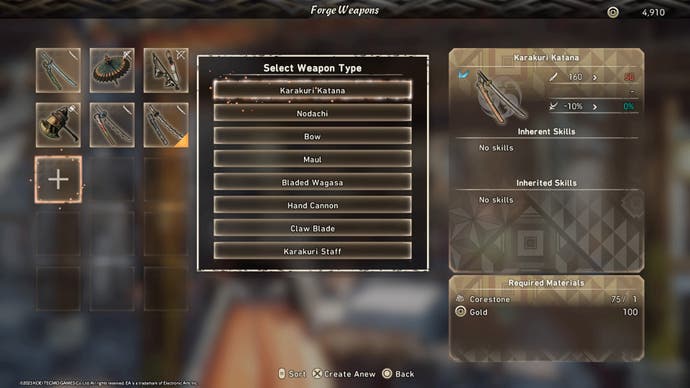Wild Hearts tips for beginners
Mastering the monster hunting basics while getting to grips with the mechanical Karakuri.
Wild Hearts is an EA-published action RPG you may not have had on your radar, yet has the makings of a sleeper hit. This is the closest we’ve seen a game come to stealing Monster Hunter’s crown while also marking a comeback for developer Omega Force after the resounding disappointment of Dynasty Warriors 9.
There’s a good chance that plenty of Monster Hunter fans will flock to Wild Hearts as they wait for the latest game in Capcom’s powerselling series. You’ll find a great deal of overlap between the two, from the boss fight-style hunts to the obsessive grind for materials.
While the game does a good job of easing new players into the enchanting world of Azuma, there’s a lot you need to learn if you’re to become a Kemono hunting machine. Here we present a handy list of Wild Hearts tips for beginners to help get the most out of those first several hours.
Use Dragon Karakuri liberally
If there’s one thing that sets Wild Hearts apart from Monster Hunter, it’s Karakuri. Powered by a mysterious celestial force, these ancient mechanisms can be summoned just about anywhere at any time, so don’t be stingy!
There are two types of Karakuri: Basic and Dragon. Basic Karakuri are expendable and combat-focused, whereas Dragon Karakuri are more permanent, base-building structures such as fast travel tents and forges. With the ability to dismantle them at any time, summon Karakuri wherever you can - as you become more knowledgeable of the different maps in Wild Hearts, you’ll figure out the best places to set up basecamps and checkpoints.

Forge more than one of each weapon
Wild Hearts features eight weapon different weapon classes, each with their own unique movesets and upgrade trees. These upgrade trees immediately splinter, branching out with a whole web of possibilities, offering different damage stats, elemental infusions, and special abilities in exchange for Kemono parts.

Once you’ve found a weapon class that suits your playstyle, make sure you visit the forge to craft multiple versions. This will allow you to go down different upgrade paths, switching between weapons to gain an advantage over whichever Kemono you are hunting. Ideally, you should aim to have one weapon of each element type.
Crafting your first loadout
Each time you successfully hunt a new Kemono more crafting options will become available. Using the parts you carve from these mythical beasts can be used to forge new weapons and armour that, when combined, create a variety of loadouts that offer differing damage, armour, and elemental resistance stats, not to mention unique passive abilities.
You will quickly become overrun with all the gear options available, making it hard to choose your first loadout. Our advice is to go ahead and ditch your beginner robes by crafting one piece of armour for each of the five slots (head, chest, arms, waist, and feet).
Don’t worry about mismatching armour from different Kemono sets as long as the core defence stat is good. Once you reach Chapter 3, however, you will need to start paying more attention to what you have equipped.

Switch off lock-on, enable other assists
For a while now, action RPGs have conditioned us to use a lock-on assist. It’s a hallmark of the 'soulslike' subgenre that is also present here, though you shouldn’t feel obliged to use it in Wild Hearts.
Kemono are large creatures and although your attacks will occasionally miss, this will be due to your timing or a change in the monster’s behaviour rather than poor aim. Once you’ve learned a weapon’s basic combos, you’ll develop a natural sense of how far attacks can reach and where they will make their impact. This is an essential skill for those late-game hunts and one that could take longer to master while using lock-on.

There are other assists that we’d recommend, however. Wild Hearts offers a whole host of accessibility features for those who need them, as well as an auto assist option that will put out a call for other players to join you whenever you embark on a hunt.
Scout first, hunt later
When visiting a new region for the first time, focus on scouting the area instead of diving straight into your next hunt. Azuma’s biomes each have their own ecosphere of unique creatures, minerals, and fauna - your in-game codex will automatically fill out as you discover these, which can help you track down certain crafting materials more efficiently.

Not only that, this initial scouting phase should be used to build Dragon Karakuri infrastructure. Place a Hunter’s Tent far away from your starting point to create a convenient fast travel point, then summon Flying Vines, Rollers, and Wind Vortexes to help navigate mountainous areas and wide plains.
Just be aware that the number of these you can build will be fairly limited until you unblock the various Dragon Pits scattered around each map, upgrading them with crystals earned from completing missions.
Don’t neglect your Tsukumo companion
In Wild Hearts, you are accompanied by an orb-like critter known as a Tsukumo. In fact, there are dozens of these hidden throughout Azuma - make sure you don’t ignore them as they can be a huge help during solo play.
Your cutesy mechanical partner can support you in a number of ways, distracting Kemono, creating a healing mist, and generating the Thread used to power your Basic Karakuri. Their influence may be subtle, though you’ll appreciate the helping hand, especially as your Tsukumo becomes more powerful.
To upgrade them you’ll need Old Cogs which are earned by finding any of the 50 Tsukumo hidden in each region. Upgrades allow you to enhance their attack, defence, and support capabilities, while also increasing your hunter’s max Thread capacity.

Break those body parts
There’s more to Kemono battles than simply whaling on your target: even after hunting the same monster a handful of times, you may still be missing the materials needed to craft new gear. Certain crafting components can only be obtained by slicing off parts of a Kemono. Furthermore, there are even rarer materials in Wild Hearts that require a Kemono to be in an enraged state when breaking a body part.
As a general rule, you should always target the head or tail of a Kemono. Deal enough damage and you’ll see these parts break off during battle - just make sure you interact with them to collect any dropped materials.

Don’t hunt on an empty stomach
Wild Hearts features a simple yet effective food system that provides your hunter with a much-needed boost before heading into battle. Food can be accessed at any time with the press of a button - this menu will display the various meats and plantlife in your inventory and the stat bonuses they offer upon consumption.
A fullness gauge prevents you from completely pigging out and while a balanced diet isn’t necessarily crucial during the early game, you’ll want to start paying close attention to what different food types do as you progress. Most will raise your max health while conferring at least one other bonus, whether that be a stat increase or elemental resistance.

Remember to coordinate your meals around which Kemono you are hunting and make sure you unlock the Dragon Karakuri drying and fermenting stations to improve food quality.
Explore Minato, the hunter’s hub
The village of Minato is where you’ll spend most of your downtime when playing Wild Hearts. Here you will find a number of important characters, vendors, and quest givers who play an important role as you progress through the story.
Naturally, you’ll want to visit Natsume the blacksmith to forge new weapons and armour, though there are other NPCs you should also interact with. Kogyoku regularly restocks a handful of useful items at her emporium, while Nobumitsu of the Fisherman guild will give out rewards for completing achievement-like challenges. Make sure you call in on Tamakazura once Minato’s bath house has been reconstructed, and make use of the training area behind your home to practice new weapon and Karakuri techniques.

These Wild Hearts beginner’s tips will help you to hit the ground running though you’ll find that there’s much to learn about this exciting action RPG. From the diverse range of weapons and advanced crafting, to your ever-growing Karakuri arsenal and the Kemono themselves, there’s a rich monster hunting experience here that will easily satisfy fans of the genre.










